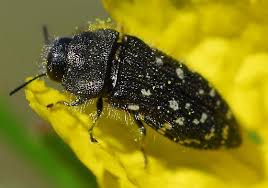
While much focus today centers around preventing terrorist attacks as far as national security, less attention has been paid to the threat of insect invaders from foreign countries that can pose a threat to urban and natural forests, as well as to the current food supply. According to Ken Cochran, the former curator of the Secrest Arboretum in Wooster, Ohio, more invasive species have entered the United States in the last 20 years then in all the time before.
A prime source for all of these new “introductions” has been the marked increase in trade with Asia, especially China. Many of the insects are hitchhikers on packaging and wood products such as pallets. It is thought that the Emerald Ash Borer that destroyed billions of ash trees was brought to the states by the way of wooden pallets that were used to transport sewer pipes from China to the Port of Detroit.
Another pest that is more insidious than the Emerald Ash Borer is the Asian Longhorned Beetle or Anoplophora glabripennis. This insect from Southeast Asia has a wide host range that includes tree species in 12 genera with the most significant being Maple. First detected in New York City in 1996, additional infestations have been detected in Chicago, Ontario, New Jersey, Illinois, Massachusetts and more recently in Ohio.
According to a news report a few years back, the federal government spent more than 252 million dollars eradicating the insect from a 62 square mile area centered around Worchester, Massachusetts by the end of 2009.
The black beetle with irregular white spots and a long antennae up to 3 ½ inches makes it easily identifiable with females much larger than the male of the species. The female will chew on twigs and young branches of trees which is known as maturation feeding followed by egg laying on the tree by chewing down through the bark and phloem layers of the tree to make an oviposition pit in which one egg is laid. The damage to the tree by adults is minimal compared to the damage caused by the larvae. Soon after hatching, the larvae bore into the tree deeply to feed on the wood portion known as xylem which is the transport system for water taken up by the roots to the tree canopy. Repeated borings of the larvae into the tree along with subsequent new hatchings of larvae will weaken the tree causing branches to break off. The current infestation in Ohio was discovered because of an alert homeowner noticed the unusual breaking of branches on maple trees in his yard.
Currently the eradication effort is still ongoing in Clermont County. According to Brent Hunt, a state nursery inspector, the eradication effort includes up to one thousand paid volunteers and appears that this effort will exceed the 252 million dollars spent in Massachusetts by the end of 2009. So far, the beetle has been eliminated; however, new infestations keep appearing in new locations.
One might wonder why doesn’t the federal regulations require only plastic pallets for importing products from China and Southeast Asia to prevent the spread of the Asian Longhorned Beetle and other wood boring insects. The USDA proposed exactly the above that was publicized by a radio report in July of 2003 as it pertained to the Emerald Ash Borer originating out of the Port of Detroit. The reply from the People’s Republic pf China of the USDA proposal is that it was a way to restrict trade with the result that nothing became of USDA’s proposal.
Milton Friedman, a now deceased well-known economist made a convincing case for the benefits of free trade in his book, Free To Choose. While Friedman’s arguments make sense, he did not factor in or did not foresee the dangers of free trade and inherit costs when the incidents of invasive species are considered as a factor.
Other well-known invasive insect species include the Hemlock Adelgid, Marmorated Stink Bug, Spotted Lanternfly, European Pine Shoot Moth and more. All have in common that without natural enemies for control, these invaders numbers can rise exponentially and quickly become a threat to urban and natural forests and a wide variety of food crops.
It remains to be seen whether the federal government will make the prevention and eradication of invasive species more of a priority than it is now as the perception is that now it is only a patchwork system of control and/or eradication that places a strain on the federal and states budgets when combating this real threat to national security.